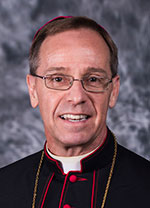Christ the Cornerstone
Mary’s intercession bring healing, hope to all her children

Tomorrow, Feb. 11, is the memorial of Our Lady of Lourdes. This is not one of the major Marian feasts, but when it is properly observed this optional memorial can serve as a vivid reminder of Mary’s role in the history of our salvation—past, present and future.
The story of Mary’s appearance to Bernadette Soubirous, a 14-year-old peasant girl, is well known. Our Lady prayed the rosary with young Bernadette. She also instructed Bernadette to dig in the ground nearby, from which came a spring with healing properties, active to this day.
After a thorough investigation, the apparitions were approved for devotion by the Catholic Church in 1862. A shrine was built there, which remains a popular place of pilgrimage. The latest approved miracle involving a healing in the water of Lourdes took place in May 1989 and after extensive investigation was approved by the Church in July 2013.
During one of her appearances in the grotto at Lourdes, the beautiful Lady dressed in white with a blue sash told Bernadette that she is the Immaculate Conception, which means that, unlike the rest of humanity, she was conceived without sin.
We Catholics believe that Mary alone among us did not inherit the stain of original sin or the tendency to make choices that were sinful. This great miracle was made possible by the grace of God in anticipation of her Son’s resurrection.
In his book, Daughter of Zion: Meditations on the Church’s Marian Belief, Cardinal Joseph Ratzinger (Pope Benedict XVI) writes that Mary’s sinlessness is a key to understanding the part that she played—and continues to play—in the history of our redemption.
Mary is an image of the Old Testament’s longing for a Savior. She stands ready when the angel Gabriel appears and communicates God’s will for her. Especially because she is without sin, she is free to accept this awesome responsibility with all its foreshadowed sorrows. Her “yes” sets in motion the tragedy, and the triumph, of her Son’s passion, death and resurrection.
Mary’s role is not incidental. Her assent to God’s will commits her to following her Son on his life’s journey. This makes Mary an image of the New Testament as well as the Old Testament. It qualifies her as the very first Christian disciple and prepares her for an all-important role at the foot of the cross.
Standing there with her crucified Son, Mary is once again asked to assume a serious responsibility as our mother and Mother of the Church. Her role in salvation history is not just something that happened long ago. It is active now as we who serve as missionary disciples of her Son, Jesus, look to her for her prayerful intercession and help.
Mary is also an image of the future—the kingdom of God which is both present and still to come. Mary’s song of praise, the Magnificat, which the Church prays daily at Evening Prayer, foresees the time when Mary’s experience will become universal. On that day, the humble will be raised from the dust, the poor will be exalted, the powerless and rejected will be ennobled beyond anyone’s expectations. This is a vision of things to come that God’s messenger revealed to a young girl in Nazareth 2,000 years ago, and which she in turn shared with a French peasant girl in Lourdes in 1858!
As we reflect on the miracles that have taken place since Mary first appeared to St. Bernadette 165 years ago, three things stand out: First, Mary continues the healing ministry of her Son. Conservative estimates state that more than 7,500 people have said that they were healed in the waters of Lourdes. Of these, the Lourdes Medical Bureau, which is not under Church control, has identified the healing of at least 70 people as “scientifically inexplicable,” which is the secular term for “miraculous.”
Secondly, Mary remains the humble servant of God even when she is exalted by the Church’s often extravagant praise. Mary does not appear to the rich and powerful or to the worldly wise. She reaches out to the poor, to peasants like Bernadette Soubirous in Lourdes and to Juan Diego Cuauhtlatoatzin in Guadalupe, on the outskirts of Mexico City, and she asks them to overcome significant obstacles in order to communicate her wishes.
Finally, Mary prays with us. Using the rosary, she invites us to meditate on the mysteries of our salvation and to walk with her, following in her Son’s footsteps on the Way of the Cross.
Tomorrow, as we celebrate this simple memorial, let’s remember that Mary our mother walks with us as the humble servant of God. May her intercession bring healing and hope to all of us, her children. †
